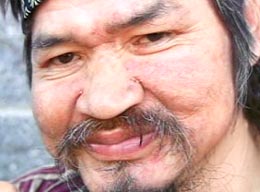On August 30, 2010, Seattle police officer Ian Birk fatally shoots Native American woodcarver John T. Williams (1960-2010) on a downtown Seattle sidewalk. Footage from Birk's dashboard camera shows Williams walking across the street at Boren Avenue and Howell Street, in front of the patrol car, carrying a board and a small knife. Birk exits the car and demands three times that Williams drop the knife. He later will claim that Williams turned toward him, "brandishing" the knife in a "very confrontational posture" (Firearms Review Board). Several witnesses come forward to refute this claim, and public outrage and protests ensue. The Seattle police department's Firearms Review Board will rule on October 4, 2010, that the shooting was unjustified. That decision will be finalized on February 15, 2011, and Birk will resign from the Seattle Police Department the following day.
A Tragic Confrontation
John T. Williams was descended from a long line of woodcarvers of the Ditidaht First Nations band on Vancouver Island. He had lived in Seattle for decades and was a familiar figure at Pike Place Market and the Seattle waterfront, where he often worked on woodcarvings and small totem poles.
On August 30, 2010, Williams, on foot, was crossing in front of Seattle police officer Ian Birk's patrol car at Boren Avenue and Howell Street in Seattle, carrying a board and a small knife. Birk got out of the car, shouted the word, "Hey" three times, and then the words, "Put the knife down!" three times (dashboard camera video). Off-camera, five shots rang out; Williams died of four gunshot wounds. A woman's voice can be heard saying "What happened? He didn't do anything" (dashboard camera video). Birk responded, "Ma'am, he had a knife and he wouldn't drop it" (dashboard camera video).
Seattle media reports reveal that Williams had been a "chronic alcoholic, drifting in and out of homelessness, detox centers, hospitals and jails for decades" (Mapes). He had also been arrested more than 100 times in Seattle since 1985, mostly on misdemeanors. However, Williams and Birk had never had any kind of previous run-in.
Public Outrage
The shooting sparked immediate protests. Jenine Grey, the executive director of the Chief Seattle Club, a shelter for Native Americans where Williams had often stayed, said "We are angry and outraged that his life was interrupted for seemingly no reason, and so callously disregarded" (Renville).
The day after the shooting, Seattle police chief John Diaz told reporters that he had "a lot more questions than answers" and that the department was no longer certain if Williams had advanced threateningly toward Birk (Green and Miletich). Williams's gunshot wounds were in his right side, indicating that Williams had "presented his profile" to Birk (Firearms Review Board). Also, the knife was a small folding knife with just a three-inch blade.
The Native American news organization Indian Country Today decried the "fact that SPD's attempts at damage control included referring to the victim as a 'chronic inebriate' with a 'rap sheet,'" and said that the shooting had "galvanized Seattle's Native community and its allies" (Renville). In one of several public protests, a window of an unoccupied Seattle police car was smashed.
Investigation and Conclusions
The Seattle Police Department's Firearms Review Board, in a preliminary finding on October 4, 2010, reached the "unequivocal conclusion" that the shooting was "unjustified" (Firearms Review Board). On January 20, 2011, a King County inquest jury delivered a split ruling. On the key question of whether Williams posed an immediate threat of serious physical harm to Birk, four jurors answered "no," one answered "yes," and three said "unknown" ("Jurors Finding").
Under state law, prosecutors face a "steep legal hurdle" in prosecuting police officers who say they use deadly force in self-defense (Miletich). On February 15, 2011, King County prosecutors indicated that they would not pursue criminal charges against Birk. On the same day, the Firearms Review Board finalized its unanimous conclusion that the shooting was "unjustified and outside of policy, tactics and training," paving the way for departmental discipline or possible termination (Firearms Review Board). Birk resigned the next day.
In 2012, federal prosecutors decided not to charge Birk under federal civil-rights statutes. The family of John T. Williams filed a wrongful death lawsuit against the City of Seattle that was settled in August 2011 for $1.5 million. On February 26, 2012, the John T. Williams Memorial Totem Pole was erected at Seattle Center and became part of the City's public art collection.

